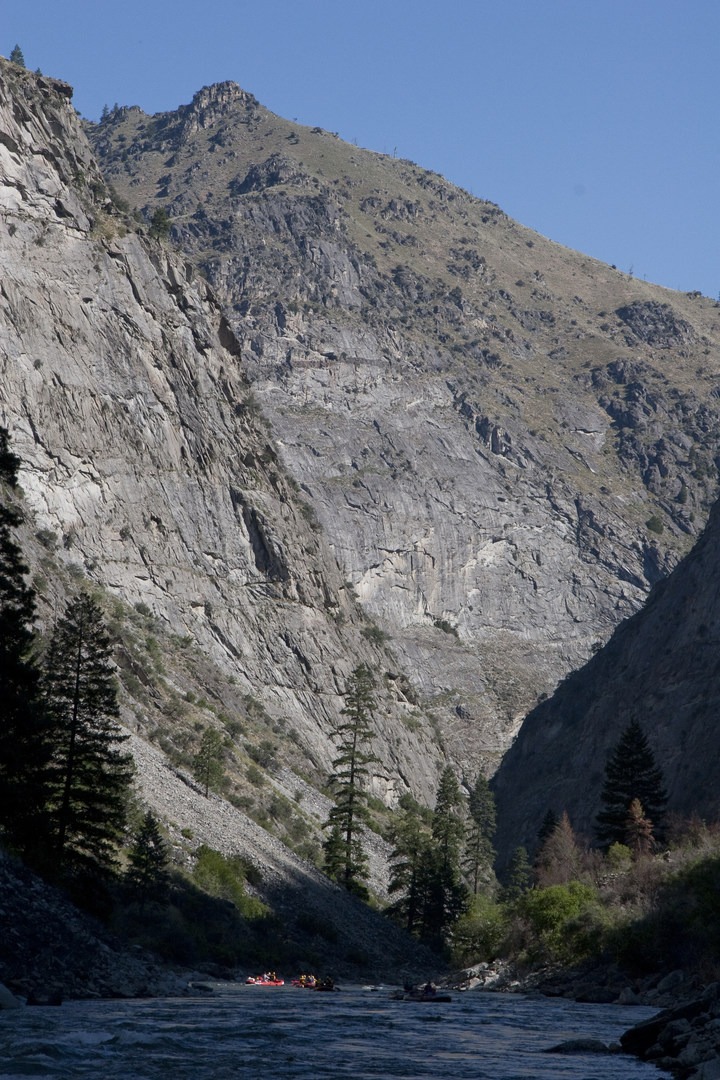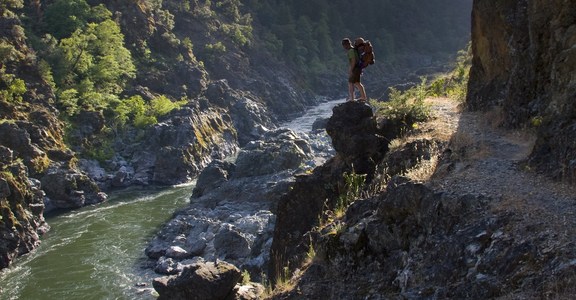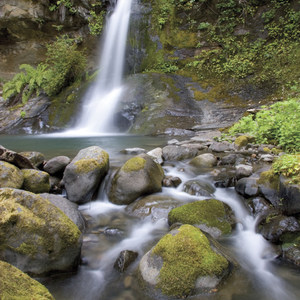You are here
These daily descriptions are intended to provide a description of a typical six-day Middle Fork rafting trip. Trip length, campsite selection, and group itineraries will vary.
For more general information about the Middle Fork check out this Adventure Overview of the river.
Day 5 - Canyon Description
The fifth day of a week-long Middle Fork rafting adventure is considered by many to be the most dramatic of the trip. It passes through the deepest and arguably most scenic canyons that harbor some of the biggest rapids on the trip.
The landscape between Driftwood Camp (mile 71.6) and Big Creek (mile 77.8) is very similar to the stretch at the end of day four. The underlying geology is composed of broken, tilted, and folded meta-sedimentary rocks that are some of the oldest in Idaho (nearing one billion years).
Sweeping, broken ridges with hillsides covered in sage and grass rise overhead. The ponderosa pines are still dominant along the riverbank, but they are even more dispersed than they are upstream. Side canyons with any hint of water are choked with woody shrubs like hawthorne, elderberry, and chokecherry.
As boaters approach the Big Creek Pack Bridge (mile 77.8) a thundering cascade pours into the river at Waterfall Creek. Just downstream of the bridge, Big Creek enters on river left and adds significant flow to the Middle Fork. For 80 miles, a foot trail has paralleled the course of the river. Below Big Creek, however, the terrain is too steep and rugged for a trail. Footpaths climb out of the canyon into the Big Horn Crags to the east and up Big Creek for several miles before turning north to parallel the canyon nearly 3,000 feet above the river.
Impassable Canyon
For the last 20 miles of its 98-mile course the Middle Fork will flow through the second deepest canyon in North America. From the 10,082-foot summit of Mount McGuire in the Big Horn Crags it is a 6,980-foot drop to the river below. Only Hells Canyon on the Snake River has a greater depth. This final stretch is known as the Impassable Canyon.
Impassable Canyon can be separated into two distinct sections, each defined by the underlying geology. The first runs from Big Creek to Mist Falls (mile 83.1), where the river carves through a massive plume of Idaho batholith granite. The uniformity of the rock results in sheer, pale granite walls that tower 1,000 to 1,500 feet over both sides of the Middle Fork. Tributaries draining the high peaks carve narrow canyons that often dead-end hundreds of feet overhead. Veil Cave (mile 80.6) is one stunning example where an unnamed creek tumbles over the lip of a natural amphitheater, a narrow ribbon that cascades through space for several hundred feet. Boaters can hike into the grotto and stand beneath as curtains of water shift in the canyon winds.
The scenery changes abruptly below Mist Falls, another beautiful cascade, when the river crosses a boundary into some intensely folded and twisted rock called metamorphic gneiss. While the Idaho batholith was notable for it’s uniformity, the gneiss is extremely varied. Different layers of dark and light rock were banded together under intense heat and pressure deep within the earth’s crust. They were then folded, twisted, and faulted into a jumble of shapes and forms. This results in a vertiginous and broken landscape composed of ragged ridges, talus slopes, and huge faces interrupted by numerous smaller cliff bands. Like Doctor Jeckel and Mister Hyde, the two disparate landscapes combine to create the remarkable Impassable Canyon.
Otter Bar, the last evening’s camp, is situated on a right bank sandbar with a stunning view down river into the narrow defile that contains Rubber Rapid, one of the most notorious drops on the river.
Day 5 - Whitewater Description
From Driftwood camp, the day begins immediately with a rapid in view of camp that can pack quite a punch at moderate river levels. Several additional read-and-run challenges will keep rafters busy until Waterfall Creek, the first Class III drop of the day. Waterfall Creek ranges from a river-wide chaos of waves and holes to a more technical run that requires some decisive moves along the left bank at low flows.
After passing the Waterfall Creek and Big Creek a long slow pool leads into Cutthroat Cove Rapid, Class III (mile 78.7). The high water wave train that passes beneath a sheer granite wall is a thrilling ride, but watch out for the skinny wrap rock that starts to come out around 3 feet. As the river carves deeper into the granite heart of the Impassable Canyon, a few more Class II and Class III wave trains hold your attention. Just around the corner from the Veil Cave (mile 80.6), the large pool at Wall Creek, Class III, slides into a wave train along the base of another overhanging granite wall. At high water, huge holes thunder in the left side of this rapid.
Below Wall Creek a long, arrow-straight corridor flanked by sheer granite walls contains a continuous stretch that will keep you busy rowing. The only named rapid, Goalpost, Class III (mile 81.3), is washed out above 4 feet, but it presents a huge crashing wave as the water drops. A massive, polished slab lurking ominously downstream at a sharp bend in the canyon marks the beginning of the Redside-Weber-Mist Falls trio of big drops.
Several huge boulders deposited at the mouth of Golden Creek create Redside Rapid, Class IV (mile 82.5). At high water there is a sneak along the far right bank that conveniently avoids a thread-the-needle line between huge crashing holes. When the sneak closes around 3 feet, boaters are faced with a hard pull left though a center channel that splits around the tall, skinny Sevy’s wrap rock. Downstream, the violent maelstrom of Weber, Class IV (mile 82.8), is a straightforward series of quick drops left of center. The power diminishes at low flows, but the left line remains constant. Mist Falls, Class III (mile 83.1), ends the series with two distinct right and left options at lower water.
The metamorphic canyon below Mist Falls offers a few longer calm sections interspersed with series of easy read-and-run rapids. The two biggest rapids, Upper and Lower Cliffside, both Class III (mile 88.6 and 88.8), are formed as the river makes a sweeping right turn around the base of a vertical wall on river left. The rapids have an inverse relationship. At high water, when Upper Cliffside is washed out, Lower Cliffside is a maze of huge holes formed by giant mid-channel boulders (stay inside left!). As the water drops, a series of big crashing waves emerges along the wall in Upper Cliffside, while the lower rapid is a diminutive and technical line among huge boulders. Ouzel Rapid, Class II, between Stoddard Camp (mile 90) and Otter Bar (mile 90.5), has plenty of room around massive holes in high water.
Previous Day – Middle Fork of the Salmon River – Day 4
Next Day – Middle Fork of the Salmon River – Day 6
Reference: All content excerpted from The Middle Fork of the Salmon River – A Comprehensive Guide by Idaho River Publications.
Logistics + Planning
Current Weather: Powered by Dark Sky







Preferable season(s)
Parking Pass
Pros
Cons
Put-in location (lat, long coordinates)
Take-out location (lat, long coordinates)
Recommended maximum flow
Recommended minimum flow
Features
Overall difficulty
Route Characteristics: Character
Suitable for
Our mission is to inspire adventure with beautiful, comprehensive and waterproof map-based guidebooks. Owner, publisher, and photographer Matt Leidecker, grew up exploring and guiding on the rivers in central Idaho. His award winning Middle Fork of the Salmon River – A Comprehensive Guide is the standard by which other river guidebooks are measured. Printed on virtually indestructible YUPO paper, IRP guides are truly unique all-in-one resources for adventure. Each book is loaded with full-color maps, stunning photographs, and information on the history, geology, and wildflowers. Visit Idaho River Publications to explore our guidebooks to the Rogue River in Oregon and the mountains of Central Idaho.


















Comments
Sign In and share them.